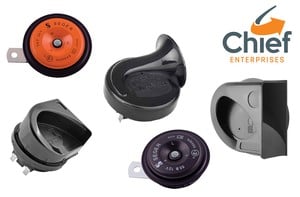Electromechanical vs. Solid State Horns
Featured Product from Chief Enterprises LLC

Electromechanical vs. Solid State Horns: Which is Right for Your Needs?
Electromechanical and solid state horns are just two types of electric horns. Even though they are similar in sound and appearance, they have very important differences that anyone looking to design-in a horn should know.
ELECTROMECHANICAL HORNS
The electromechanical horn operates with fairly basic components: plunger, diaphragm, coil of wire, tuning screw, and contacts. Basically, when the horn is activated, the coil of wire creates a magnetic field that moves the plunger and diaphragm inwards, which then breaks the connections of the contacts. This interrupts the flow of current, leading to the dissipation of the magnetic field. Now, the plunger and diaphragm return to the resting position, causing the contacts to reconnect and for current to flow once again. This happens so quickly, that in the time it takes you to blink, the diaphragm will move back and forth 100-170 times, depending on the frequency of the horn (this cycle is explained with much more detail here).
The distance between the contacts can be changed with the tuning screw, which then changes how long the cycle takes, and therefore the frequency of the sound. This constant breaking of a circuit causes the contacts to eventually wear out, meaning they are usually the limiting component of the horn’s life expectancy. Typical electromechanical horns will usually last for a minimum of 50,000 beeps. However, Chief represents the vendor, Seger, whose horns are tested and proved for 100,000 beeps. This makes Seger horns the obvious choice if you want to get a bigger bang for your buck.
SOLID STATE HORNS
Solid State horns are made of almost the same exact components, the only difference is that an integrated circuit (IC) takes the place of the tuning screw and contacts. The IC is able to regulate pulses of current to the horn instead of using the contact method. It also permits the ability to adjust the length of the pulses and how much time there is between them — eliminating the need for the tuning screw.
Without the need for contacts, there is no longer a concern for wear and tear, therefore, removing the life expectancy limitation of the horn. This means that solid state horns are guaranteed to operate for 1 million beeps! The superior functionality of solid state horns make them one of the most premium warning device options on the market. They are most commonly used in the European and Asian markets, but are ideal for any application that requires extensive use.



